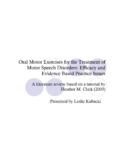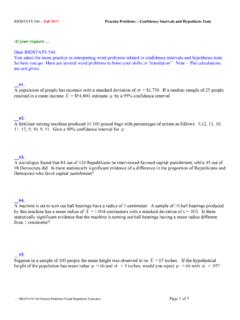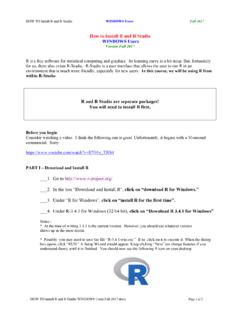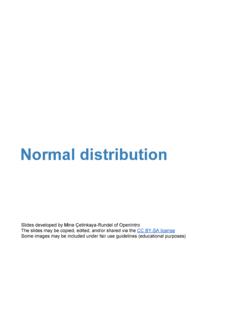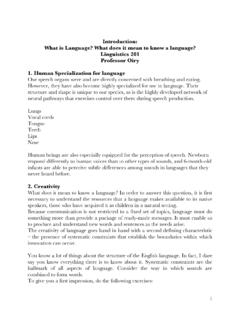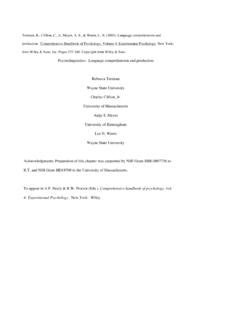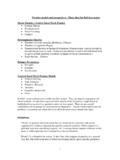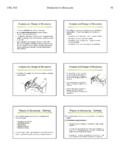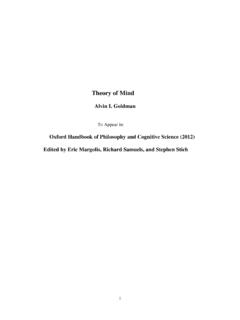Transcription of Behavioral Interventions Based on the Theory of Planned ...
1 Interventions with the TPB 1 Behavioral Interventions Based on the Theory of Planned behavior Icek Ajzen Brief Description of the Theory of Planned behavior According to the Theory , human behavior is guided by three kinds of considerations: beliefs about the likely consequences of the behavior ( Behavioral beliefs), beliefs about the normative expectations of others (normative beliefs), and beliefs about the presence of factors that may facilitate or impede performance of the behavior (control beliefs). In their respective aggregates, Behavioral beliefs produce a favorable or unfavorable attitude toward the behavior ; normative beliefs result in perceived social pressure or subjective norm; and control beliefs give rise to perceived Behavioral control or self-efficacy.
2 The effects of attitude toward the behavior and subjective norm on intention are moderated by perception of Behavioral control. As a general rule, the more favorable the attitude and subjective norm, and the greater the perceived control, the stronger should be the person s intention to perform the behavior in question. Finally, given a sufficient degree of actual control over the behavior , people are expected to carry out their intentions when the opportunity arises. Intention is thus assumed to be the immediate antecedent of behavior . To the extent that perceived Behavioral control is veridical, it can serve as a proxy for actual control and contribute to the prediction of the behavior in question. The following figure is a schematic representation of the Theory .
3 Interventions with the TPB 2 Behavioral Interventions Interventions designed to change behavior can be directed at one or more of its determinants: attitudes, subjective norms, or perceptions of Behavioral control. Changes in these factors should produce changes in Behavioral intentions and, given adequate control over the behavior , the new intentions should be carried out under appropriate circumstances. Formative Research Eliciting and Measuring Accessible Beliefs Because attitudes, subjective norms, and perceived Behavioral control are assumed to be Based on corresponding sets of beliefs, Behavioral Interventions must try to change the beliefs that, according to the Theory , ultimately guide performance of the behavior .
4 It is important to realize, however, that this explanatory function is associated only with salient beliefs or, to use the currently favored term, beliefs that are readily accessible in memory. Pilot work is required to identify accessible Behavioral , normative, and control beliefs. Respondents are given a description of the behavior and are asked a series of questions designed to elicit accessible beliefs (for details, see Constructing a TPB Questionnaire on this website). The responses can be used to identify personal accessible beliefs, , the unique beliefs of each research participant, or to construct a list of modal accessible beliefs, , a list of the most commonly held beliefs in the research population. Once accessible beliefs have been identified, a standard TPB questionnaire can be constructed (again, see Constructing a TPB Questionnaire on this website for instructions).
5 This questionnaire is administered in the second stage of the formative research. It includes direct measures of attitudes, subjective norms, perceptions of Behavioral control, intentions, and actual behavior . By using multiple regression or structural equation analyses, we can determine the relative contributions of attitudes, subjective norms, and perceptions of Behavioral control to the prediction of intentions; and the relative contributions of intentions and perceptions of control to the prediction of behavior . In addition, the questionnaire also assesses Behavioral beliefs (beliefs strength and outcome evaluations), normative beliefs (strength and motivation to comply), and control beliefs (strength and perceived power). By measuring these beliefs, we gain insight into the underlying cognitive foundation, , we can explore why people hold certain attitudes, subjective norms, and perceptions of Behavioral control.
6 The beliefs provide a snapshot of the behavior s cognitive foundation in a given population at a given point in time. Developing and Pretesting the Intervention Once it has been decided which beliefs the intervention will attempt to change, an effective intervention method must be developed. This is where the investigator s experience and creativity come into play. The Theory of Planned behavior can provide general guidelines, described below, but it does not tell us what kind of intervention will be most effective. We could consider persuasive communications, perhaps in the form of newspaper ads, flyers distributed in certain neighborhoods, or TV service messages. Alternatively, we might want to try face-to-face discussions, observational modeling, or any other applicable method.
7 The purpose of this third phase of the formative research is to demonstrate that the intervention developed does indeed influence the beliefs it is designed to change. Interventions with the TPB 3 Targeting the Intervention Mean Levels of Predictor Variables When selecting a target for the Behavioral intervention, one obvious consideration is whether there is much room for change in the designated target. Consider, for example, an intervention designed to increase breast self-examination among African-American women over 40. If the formative research shows that, on average, women in this population hold very positive attitudes toward the behavior in question, an intervention designed to make their attitudes more favorable is unlikely to influence their behavior .
8 The formative research may, however, reveal relatively low perceptions of control over performing breast self-examinations. In that case, an intervention designed to raise perceived Behavioral control would be called for. Relative Weights of Predictor Variables If the formative research shows that there is room for change in two or all three predictors, it is possible to consider their relative weights in the prediction of intentions and behavior to target the intervention. Generally speaking, the greater the relative weight of a given factor, the more likely it is that changing that factors will influence intentions and behavior (see Ajzen, 1971). Consider, for example, a case where attitudes toward the behavior explain a great deal of variance in intentions, subjective norms and perceptions of Behavioral control contribute relatively little, and intentions account for most of the variance in behavior .
9 It would seem reasonable to direct the intervention at Behavioral beliefs in an attempt to make attitudes toward the behavior more favorable, thus affecting intentions and behavior . This is not the only possible approach, however, and it may not even be the most effective approach. Estimates of the relative weights of attitudes, subjective norms, and perceptions of Behavioral control are provided by standardized regression coefficients or by path coefficients. These weights are usually interpreted as corresponding to the relative importance of the predictors. Unfortunately, however, regression or path coefficients are affected by factors that may have little to do with the relative importance of the different predictors. Importantly, they are influenced by the degree of variance in the items used to assess the predictors.
10 To return to the above example, imagine that a large proportion of women in the population have low perceived control over performing breast self-examinations. Because of the low variability in responses, perceived control would not correlate well with intentions or behavior and would thus receive a low regression or path coefficient. Nevertheless, an intervention that succeeded in raising the level of perceived Behavioral control among an appreciable proportion of women could produce a considerable increase in the rate of breast self-examinations. Moreover, following the intervention, there may be much more variability in perceived Behavioral control, and we may now see a strong coefficient for this factor in the prediction of intentions and behavior .
